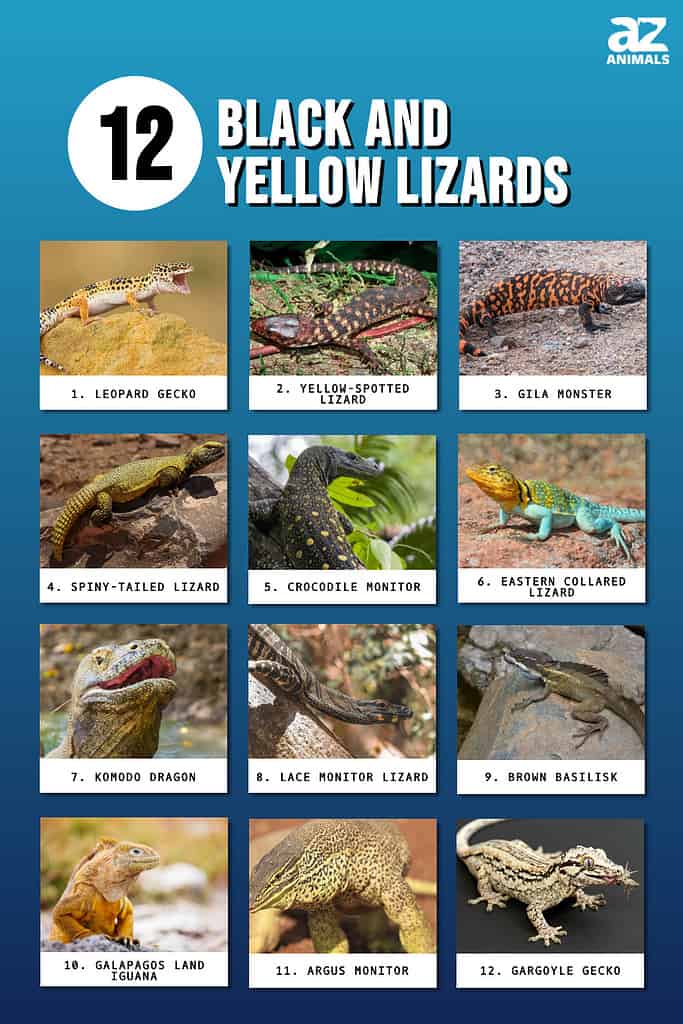
If you’re a fan of the black and yellow color scheme, you’ll be pleased to know there are some cool reptiles out there that have this color combination. Black and yellow lizards are a group of reptiles that have distinctive black and yellow coloration. This color combination is seen in a wide variety of lizard species, which are widespread around the world.
These lizards can live in many habitats and have a range of body sizes and forms. Some are semi-aquatic or terrestrial, while others are arboreal, meaning they live in trees. Given that it might suggest that the lizard is poisonous, venomous, or otherwise hazardous, the black and yellow coloring of these lizards is often utilized as a warning signal to prospective predators. Isn’t nature cool?
In this guide, we’ll take a look at some of the most well-known and fascinating black and yellow lizards out there. Some of these entries may just surprise you!
1. Leopard Gecko
The leopard gecko is classified as Eublepharis macularius. This type of lizard can be black and yellow, as well as a host of other colors depending on the specimen’s specific morph. It is a type of lizard that is extremely popular in the pet trade. In fact, some people think they were the first lizard species to be tamed and kept as pets. These reptiles live on the ground and are unable to climb smooth vertical walls like other geckos. Still, what they lack in arboreal stealth, they make up for with their serious cuteness.
The lizard’s name derives from the way it looks. A stunning creature, the leopard gecko has a dorsal side that is yellow and is covered in black markings that resemble those on a leopard. It is known for almost always having a white belly, regardless of morph. This gecko can conceal itself from danger because of its skin pattern as well.
Leopard geckos males can grow to be eight to 11 inches long. Females can grow to a length of seven to eight inches. India, Iran, Afghanistan, Pakistan, and Nepal are countries where leopard geckos may be found in the wild. However, they are widely available in captivity and are extremely popular in the pet trade.

The black and yellow leopard gecko (pictured) is very popular in the pet trade.
©Milan Zygmunt/Shutterstock.com
2. Yellow-Spotted Lizard
The yellow-spotted lizard, also known as the yellow-spotted tropical night lizard, is classified as Lepidophyma flavimaculatum. The yellow-spotted lizard is among this list’s most intriguing and vividly colored black and yellow lizards. Native to the Americas, this species of tiny lizard can be found in moist tropical woods. It is a very venomous reptile as well. If antivenom is not administered, its venom is exceedingly dangerous. It can produce excruciating agony and may even result in death. So, don’t go looking for this specific lizard if you can help it!
The yellow-spotted lizard, as its name implies, has a body that is entirely black with yellow dots covering the dorsal and ventral sides of it. The reptile has yellow patterns on its head and tail, as well as close to its lips. This lizard, which is around 10 inches in length, is widespread throughout Central America and Mexico.
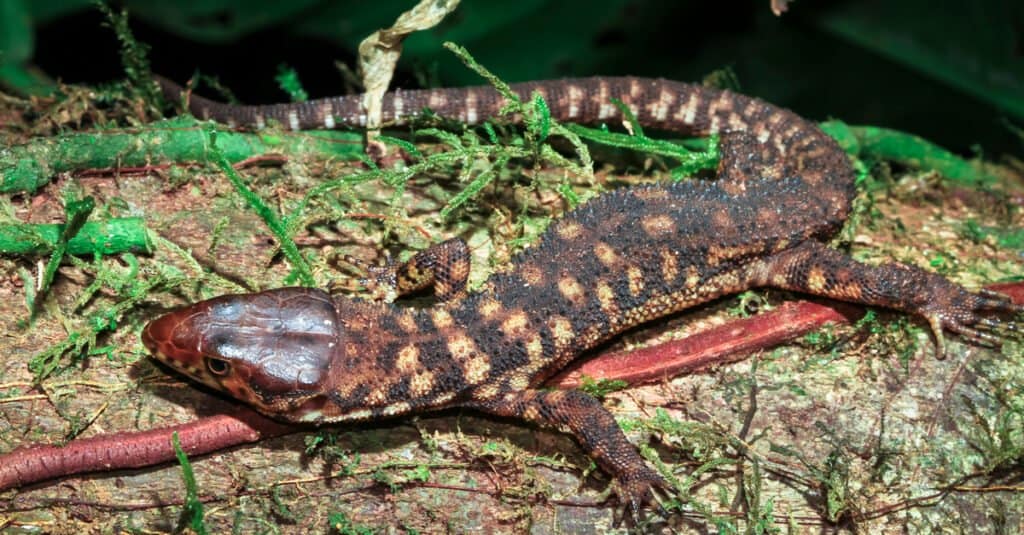
The yellow-spotted lizard (pictured) can be found throughout damp, tropical forests throughout Central America.
©Kevin Wells Photography/Shutterstock.com
3. Gila Monster
The Gila monster is classified as Heloderma suspectum. The southwestern United States and northwest Mexico are home to the huge, venomous reptiles known as Gila monsters. A huge, blunt skull, short legs, and a stocky body give these reptiles their characteristic look, which makes them easily identifiable. Their rough, bumpy yellow-orange scales that cover their black skin help them retain moisture in their dry surroundings. Just as well, Gila monsters are distinguished by their striking yellow-orange and black coloring, which warns off prospective predators.
Despite having a venomous bite, Gila monsters seldom attack people and only do so when provoked or in peril. Small animals, birds, and reptiles are among the prey that their venom is most commonly used for. Due to habitat degradation, human persecution, and the illicit pet trade, Gila monsters are an endangered species. These interesting reptiles and their distinctive desert environment are currently the subjects of conservation efforts.
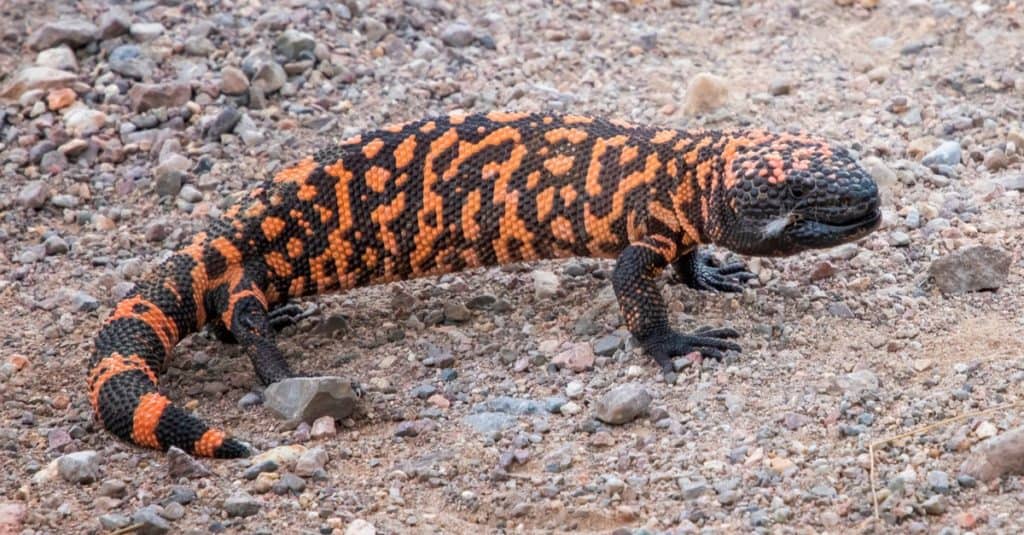
Gila monsters (pictured) can look more orange or more yellow, depending on the specimen.
©Erin Donalson/Shutterstock.com
4. Spiny-Tailed Lizard
The spiny-tailed lizard or Uromastyx lizard refers to a number of lizard species in the genus Uromastyx. Asia and Africa are home to the lizards of the genus Uromastyx, which includes the spiny-tailed lizard. This genus is known for its nonvenomous, average-sized lizards. The tail of the spiny-tailed lizard is distinctively spiky and thickest towards the center. The lizards of the genus Uromastyx come in a broad range of hues. The color combination of black and yellow is one of the most popular.
This lizard’s body is covered in black spots with yellow patterns, particularly on the head and tail. Very small marks can be seen predominantly between the two eyes on the head. The body and tail have more prominent markings. The majority of lizards in this genus may grow to a length of 10 to 36 inches. In Iran, most of the Middle East, and north Africa, they can be found in the wild.
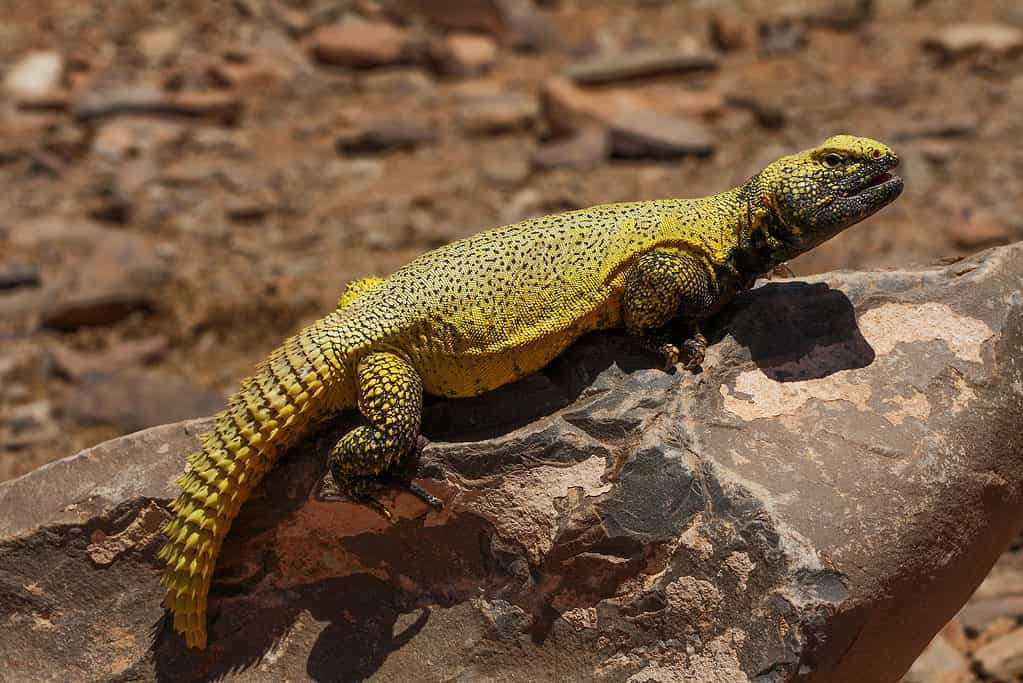
The spiny-tailed lizard (pictured) can come in a wide range of colors, but is mostly just yellow and black.
©Dan_Koleska/Shutterstock.com
5. Crocodile Monitor
The crocodile monitor lizard is classified as Varanus salvadorii. One of the world’s longest lizards is the crocodile monitor. This lizard, which is native to New Guinea, has unfortunately been harmed by habitat degradation and hunting. Because of this, international and local laws now protect the lizard species. Although venomous, the crocodile monitor is not particularly dangerous to humans.
The crocodile monitor is a large reptile that is mostly black with yellow markings. The patterns extend to the tail and are more pronounced in the neck area. The lizard’s face is blunt, and some of them have a yellow hue to their mouths and snouts. This type of lizard may reach lengths of 45 to 50 inches.
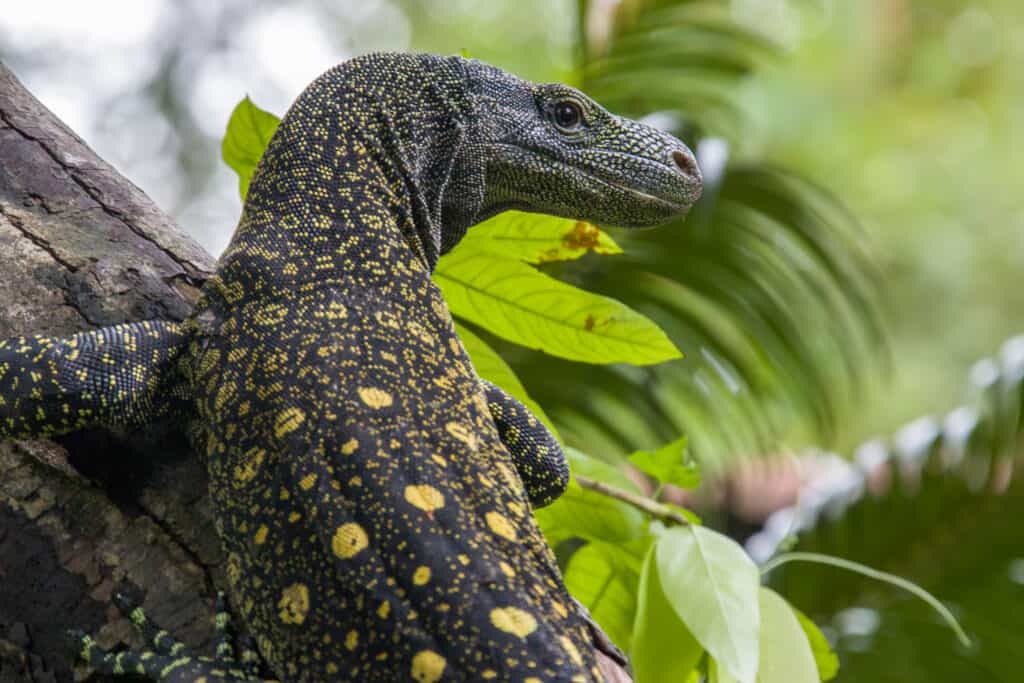
The crocodile monitor (pictured) is a large type of lizard known for its yellow spots.
©Danny Ye/Shutterstock.com
6. Eastern Collared Lizard
The eastern collared lizard, also known as the yellow-headed collared lizard, is classified as Crotaphytus collaris. The eastern collared lizard species is native to North America. When fleeing from predators, this lizard can move very quickly on two legs. The males and females of the species exhibit sexual dimorphism, which means they have very distinct appearances from one another. Eastern collared lizard males have vividly colored skin that is sky blue, yellow, and blue-green. More subdued hues of black and yellow are found on female specimens. Their heads have brown markings, and their skin has a brownish-gray color.
The black collar in the shape of a bar that surrounds the lizards’ necks gives this species its name. This trait is shared by both sexes. The eastern collared lizard may grow to a length of eight to 15 inches. Mexico and the south-central United States are both home to this species.
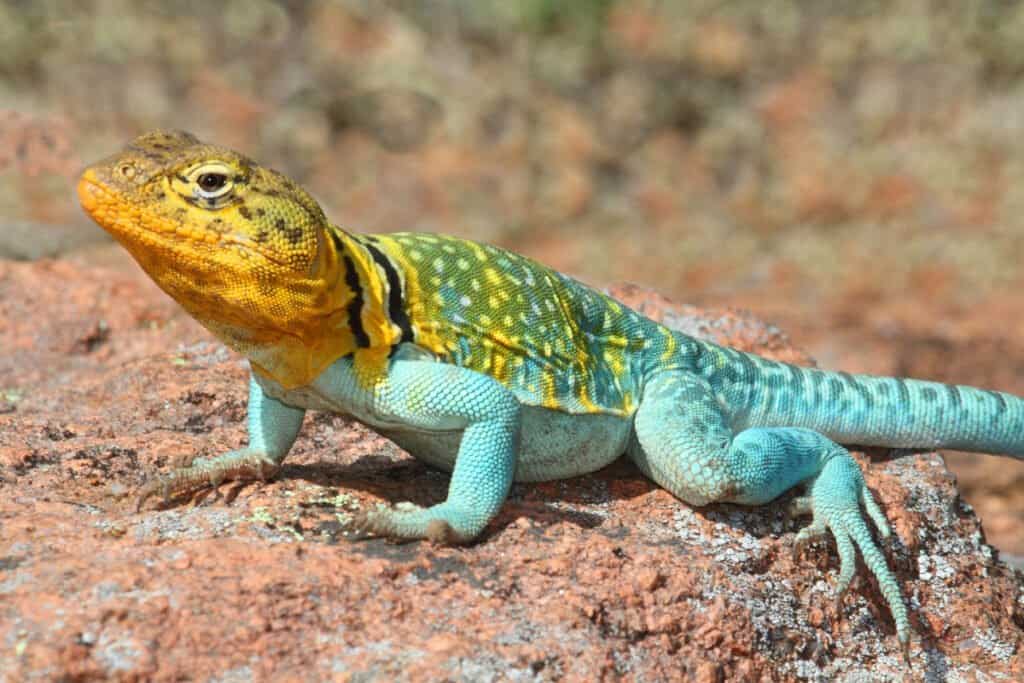
Eastern collared lizards (pictured) can be yellow and black, as well as blue-green and turquoise.
©iStock.com/SteveByland
7. Komodo Dragon
The Komodo dragon or Komodo monitor lizard is classified as Varanus komodoensis. This well-known type of black and yellow lizard is native to Indonesia. It can grow to a maximum length of 10 feet and weighs around 150 pounds, making it the largest lizard in the entire world. The Komodo dragon is also quite venomous. Its venom stops blood from clotting, lowers blood pressure, paralyzes muscles, induces hypothermia and shock, and renders victims comatose. To put it simply, these lizards are best enjoyed at your local zoo, behind glass.
The Komodo dragon’s scales are armored and range in color from olive green to black. The entire body is covered in tiny yellow spots, which are more prominent on the front and rear than the borders. Yellow dots are also scattered along the tail. Yellow outlines the lizard’s eyes as well. Male Komodo dragons may grow up to eight and a half feet in length on average. Females grow to a length of almost seven and a half feet. The Indonesian islands of Komodo, Rinca, Flores, and Gili Motang are the native homes of the Komodo dragon.

Komodo dragons (pictured) are usually yellow and black, but can also appear olive-green and black.
©vladivlad/Shutterstock.com
8. Lace Monitor Lizard
The lace monitor lizard or tree goanna is classified as Varanus varius. In Australia, the lace monitor is the second-largest member of its genus. It typically weighs 30 pounds and reaches a maximum length of roughly seven feet. This black and yellow reptile contains venom glands and can create venom that is comparable to snake venom, although it is not dangerously potent. However, a bit from a lace monitor definitely hurts and can result in bruising and blood clotting.
The neck of the lace monitor is long and thick. Its body is covered in yellow dots-like patterns with a black base color, giving the black patches of skin a striped appearance. On the side of the abdomen and the limbs, the spaces between each black patch are wider, while they are smaller on the back.

The lace monitor lizard (pictured), like most monitor species, is black and yellow in hue.
©Fayeem, CC BY-SA 4.0 – License
9. Brown Basilisk
Despite its name, this lizard is definitely yellow and black in hue. The brown basilisk, also known as the striped basilisk, is classified as Basiliscus vittatus. The brown basilisk is a species of reptile well-known for being able to traverse water. Although it appears to be running on water, the lizard really moves quite swiftly because of its huge hind feet and tiny skin flaps on each toe. Basilisks have a distinctive appearance, and the brown basilisk in particular looks very dinosaur-like.
This lizard’s most common body color is brown, as its name would imply. However, it is also common for these basilisks to have black skin that becomes reddish brown on the ventral side. Its spine is usually brown. This species has two distinct sets of yellow stripes that flow from the head to the tail. This species has a maximum length of 24 inches. It can be found all throughout Mexico, Colombia, and Central America.
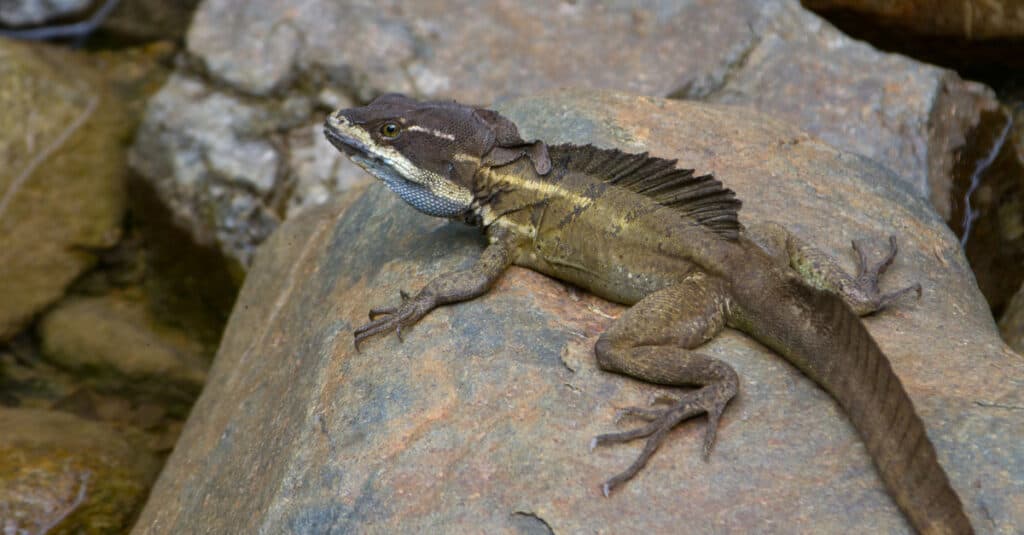
The brown basilisk (pictured) can either be black and yellow or brown and yellow.
©Elliotte Rusty Harold/Shutterstock.com
10. Galapagos Land Iguana
The Galapagos land iguana is classified as Conolophus subcristatus. As its name indicates, the Galapagos land iguana is a type of reptile that is unique to the Galapagos islands. The IUCN has classified it as Vulnerable due to its extremely constrained range and tiny population size. Just as well, there is a symbiotic interaction between the birds of the islands and this special species of lizard.
The Galapagos land iguana is a large reptile with dark brown to black skin. The lizard’s ventral side, which extends from the margins of the dorsal side, is entirely yellow. Yellow spots are scattered all over its limbs. The iguana’s vertebra is covered with a row of yellow-orange spines. Under its chin, the Galapagos land iguana displays an overgrowth of wrinkled skin. These lizards may grow to a maximum length of five feet.
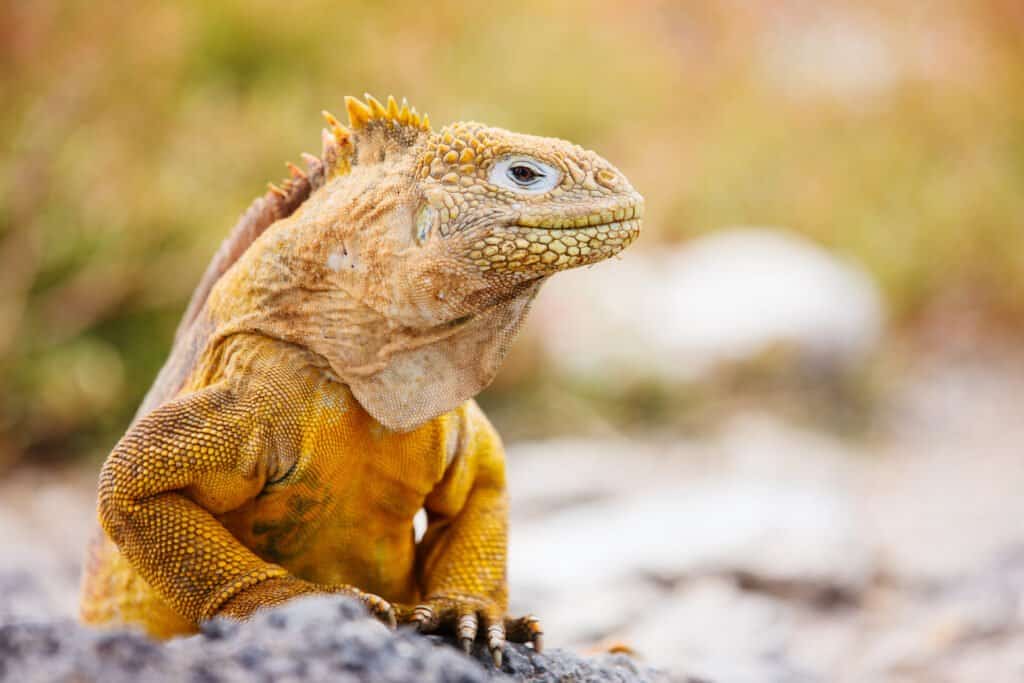
The Galapagos land iguana (pictured) can be substantially yellow in color.
©BlueOrange Studio/Shutterstock.com
11. Argus Monitor
The Argus monitor or the yellow-spotted monitor is classified as Varanus panoptes. It is a huge, impressive lizard that lives in Southeast Asian grasslands and woodlands. Their strikingly patterned skin, which has brilliant yellow spots and bands on a dark brown or black backdrop, is what gave them their name.
Argus monitors are formidable predators and are known to consume a wide range of prey, including insects, small animals, and birds. They are renowned for having exceptional climbing skills, which enable them to hunt in shrubs and trees. Due to their amazing size and captivating look, these lizards are also common in the exotic pet trade. To survive in captivity, however, they need a sizable cage with lots of room for climbing and sunbathing, as well as diverse food sources and appropriate care.
The loss of their natural habitat in Australia and New Guinea have put argus monitors in danger in the wild. To save these distinctive and intriguing reptiles and their natural environment, conservation activities are currently in motion.
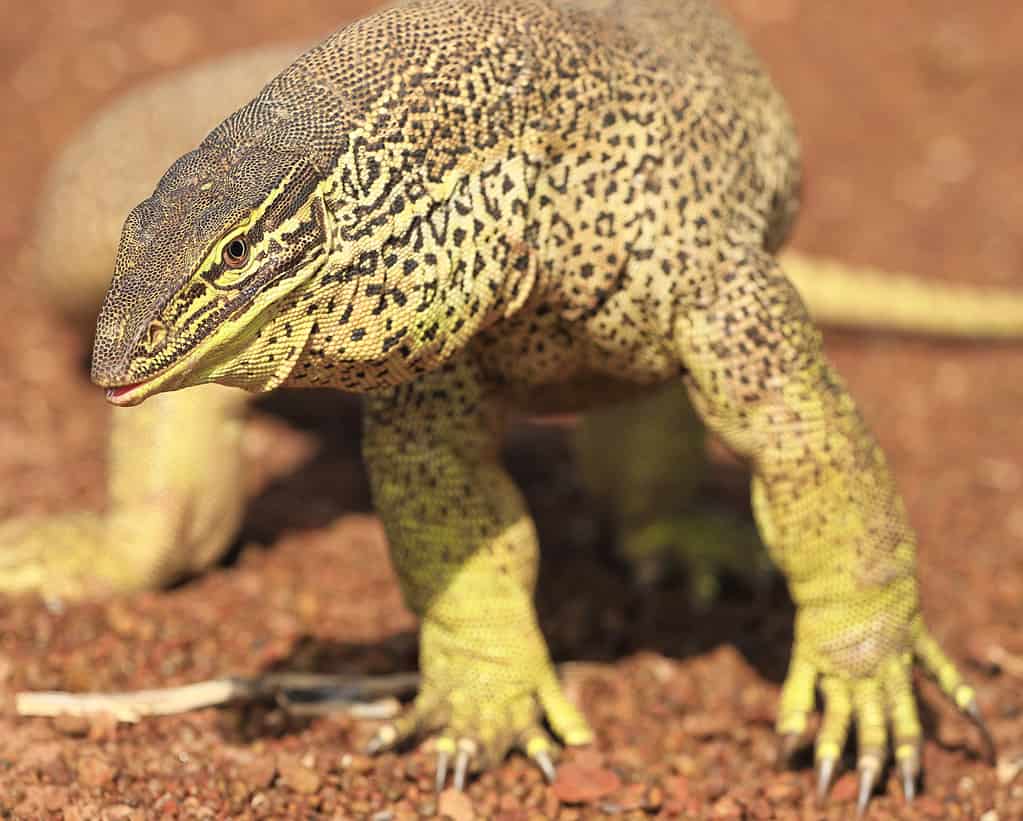
The argus monitor (pictured) is currently at risk in its native habitats in Australia and New Guinea.
©Matt Cornish/Shutterstock.com
12. Gargoyle Gecko
The gargoyle gecko, also known as the knob-headed giant gecko, is classified as Rhacodactylus auriculatus. The island of New Caledonia in the southwest Pacific Ocean is home to the tiny (and quite adorable) gargoyle gecko. The gargoyle gecko is actually its genus’s smallest species. It seldom grows over nine inches in length. Deforestation on the island of New Caledonia is presently putting this gecko species in danger, prompting governmental organizations to seek preventive measures.
The look of gargoyle geckos is quite distinctive. The cranial lumps on its head are where it gets its name. This fascinating little creature’s prehensile tail is another distinguishing trait. The skin of this reptile comes in a variety of hues. Some of its morphs have a vertical design in pale yellow and black. Gargoyle geckos are also quite popular in the pet trade.
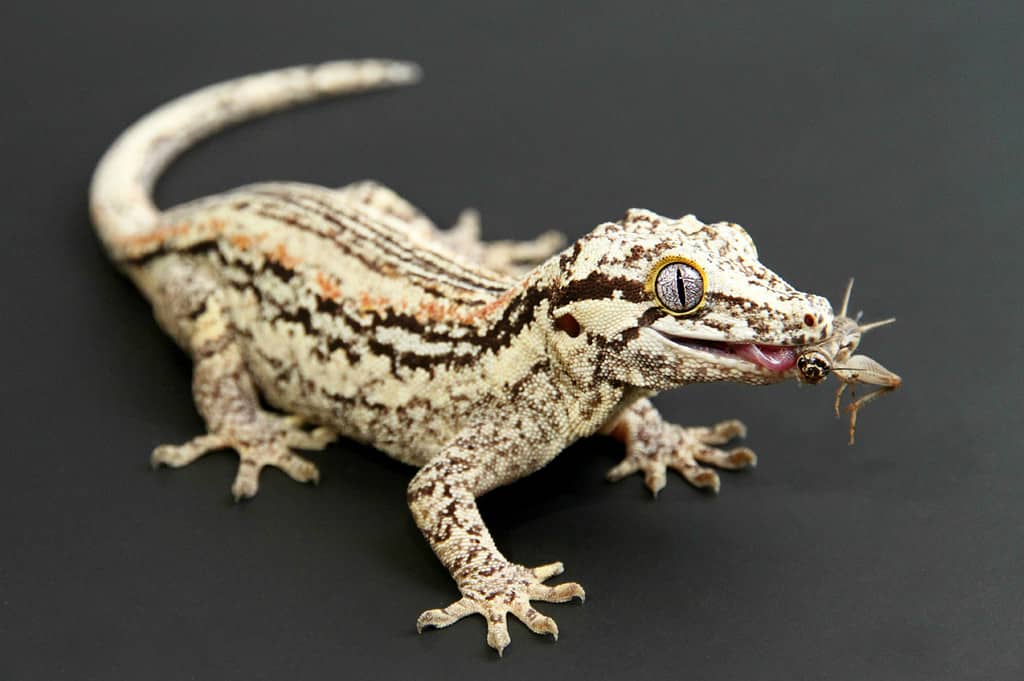
The gargoyle gecko can be black and yellow (pictured) but can also have a range of other body colors.
©Naturesauraphoto/Shutterstock.com
Black and yellow lizards are few and far between. However, the above species we’ve explored really are stunning to look at. You might not find any of these species easily, but it is definitely worth a herping trip or two to see if you can catch them.
Summary of 12 Black and Yellow Lizards
| Number | Black and Yellow Lizard |
|---|---|
| 1 | Leopard Gecko |
| 2 | Yellow-Spotted Lizard |
| 3 | Gila Monster |
| 4 | Spiny-Tailed Lizard |
| 5 | Crocodile Monitor |
| 6 | Eastern Collared Lizard |
| 7 | Komodo Dragon |
| 8 | Lace Monitor Lizard |
| 9 | Brown Basilisk |
| 10 | Galapagos Land Iguana |
| 11 | Argus Monitor |
| 12 | Gargoyle Gecko |
The photo featured at the top of this post is © iStock.com/LeitnerR
Thank you for reading! Have some feedback for us? Contact the AZ Animals editorial team.






